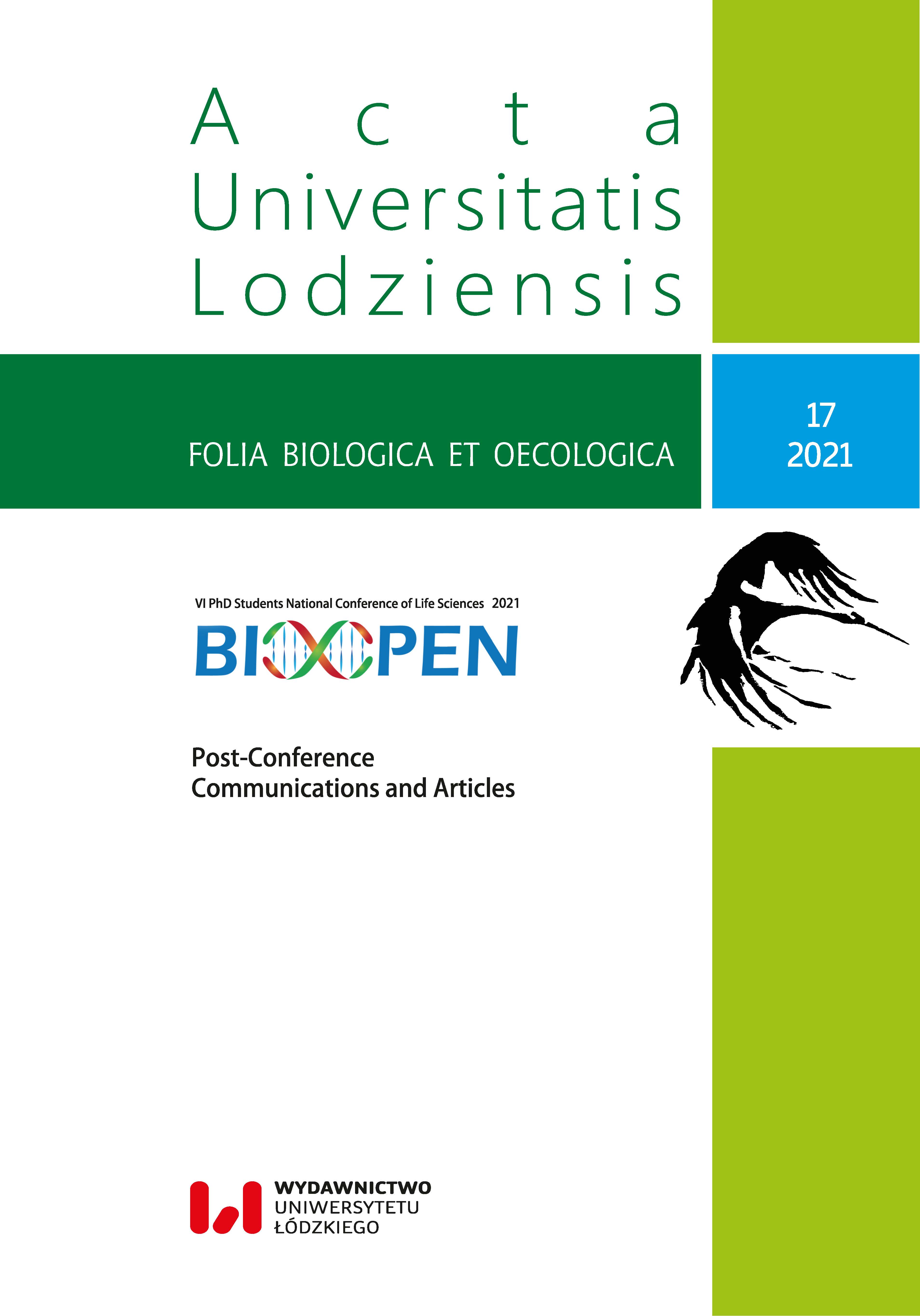Buffer composition affects rose bengal dialysis rate through cellulose membrane
DOI:
https://doi.org/10.18778/1730-2366.16.11Keywords:
nanocarriers, dialysis, rose bengal, photodynamic therapyAbstract
Due to its fluorescent and phototoxic properties, rose bengal (RB) is used in photodynamic therapy. To improve the delivery of RB to its site of action, the application of nanocarrier systems has been proposed. The most promising approach includes the use of pH-responsive nanoparticles. To evaluate the pattern of drug release in different buffers, equilibrium dialysis is commonly used. Here, we used water and two buffers to determine the impact of solvent composition on the aggregation and dialysis rate of RB through a cellulose membrane. The results show that buffer composition does not influence the fluorescent properties of RB. However, the presence of additional ions causes a change in diffusion rate that is most probably linked to the size of RB aggregates.
Downloads
References
Alexander, W. 2010. American Society of Clinical Oncology, 2010 Annual Meeting and rose bengal: from a wool dye to a cancer therapy. Pharmacy and Therapeutics, 35: 469–474.
Google Scholar
Allison, R.R., Downie, G.H., Cuenca, R., Hu, X.H., Childs, C.J.H., Sibata, C.H. 2004. Photosensitizers in clinical PDT. Photodiagnosis and Photodynamic Therapy 1(1): 27–42.
Google Scholar
DOI: https://doi.org/10.1016/S1572-1000(04)00007-9
Apartsin, E., Knauer, N., Arkhipova, V., Pashkina, E., Aktanova, A., Poletaeva, J., Sánchez-Nieves, J., de la Mata, F.J., Gómez, R. 2020. pH-sensitive dendrimersomes of hybrid triazine-carbosilane dendritic amphiphiles-smart vehicles for drug delivery. Nanomaterials 10(10): 1–15.
Google Scholar
DOI: https://doi.org/10.3390/nano10101899
Bron, A.J., Evans, V.E., Smith, J.A. 2003. Grading of corneal and conjunctival staining in the context of other dry eye tests. Cornea 22(7): 640–650.
Google Scholar
DOI: https://doi.org/10.1097/00003226-200310000-00008
Capinera, J.L., Squitier, J.M. 2000. Insecticidal activity of photoactive dyes to American and migratory grasshoppers (Orthoptera: Acrididae). Journal of Economic Entomology 93(3): 662–666.
Google Scholar
DOI: https://doi.org/10.1603/0022-0493-93.3.662
Cold Spring Harbor Protocols. 2006. Phosphate-buffered saline (PBS). Cold Spring Harbor Protocols 2006(1): pdb.rec8247.
Google Scholar
DOI: https://doi.org/10.1101/pdb.rec8247
Cossu, A., Ercan, D., Tikekar, R.V., Nitin, N. 2016. Antimicrobial effect of photosensitized rose bengal on bacteria and viruses in model wash water. Food and Bioprocess Technology 9(3): 441–451.
Google Scholar
DOI: https://doi.org/10.1007/s11947-015-1631-8
Dabrzalska, M., Janaszewska, A., Zablocka, M., Mignani, S., Majoral, J.P., Klajnert-Maculewicz, B. 2017. Cationic phosphorus dendrimer enhances photodynamic activity of rose bengal against basal cell carcinoma cell lines. Molecular Pharmaceutics 14(5): 1821–1830.
Google Scholar
DOI: https://doi.org/10.1021/acs.molpharmaceut.7b00108
Gianotti, E., Estevão, B.M., Cucinotta, F., Hioka, N., Rizzi, M., Renò, F., Marchese, L. 2014. An efficient rose bengal based nanoplatform for photodynamic therapy. Chemistry – A European Journal 20(35): 10921–10925.
Google Scholar
DOI: https://doi.org/10.1002/chem.201404296
Haney, P., Herting, K., Smith, S. 2013. Separation characteristics of dialysis membranes. Pierce previews. Pierce Protein Biology Products, 2–6.
Google Scholar
Karimi, M., Eslami, M., Sahandi-Zangabad, P., Mirab, F., Farajisafiloo, N., Shafaei, Z., Ghosh, D., Bozorgomid, M., Dashkhaneh, F., Hamblin, M.R. 2016. pH-sensitive stimulus-responsive nanocarriers for targeted delivery of therapeutic agents. Wiley Interdisciplinary Reviews: Nanomedicine and Nanobiotechnology 8(5): 696–716.
Google Scholar
DOI: https://doi.org/10.1002/wnan.1389
Patel, S.P., Carter, B.W., Murthy, R., Sheth, R., Agarwala, S.S., Lu, G., Redstone, E., Balmes, G.S., Rider, H., Rodrigues, D., Wachter, E.A. 2020. Percutaneous hepatic injection of rose bengal disodium (PV-10) in metastatic uveal melanoma. Journal of Clinical Oncology 38(15 suppl): 3143.
Google Scholar
DOI: https://doi.org/10.1200/JCO.2020.38.15_suppl.3143
Patri, A.K., Kukowska-Latallo, J.F., Baker, J.R. 2005. Targeted drug delivery with dendrimers: comparison of the release kinetics of covalently conjugated drug and non-covalent drug inclusion complex. Advanced Drug Delivery Reviews 57(15): 2203–2214.
Google Scholar
DOI: https://doi.org/10.1016/j.addr.2005.09.014
Qin, J., Kunda, N., Qiao, G., Calata, J.F., Pardiwala, K., Prabhakar, B.S., Maker, A.V. 2017. Colon cancer cell treatment with rose bengal generates a protective immune response via immunogenic cell death. Cell Death and Disease 8(2): e2584.
Google Scholar
DOI: https://doi.org/10.1038/cddis.2016.473
Snyder, C., Paugh, J.R. 1998. Rose bengal dye concentration and volume delivered via dye-impregnated paper strips. Optometry and Vision Science 75 (5): 339–341.
Google Scholar
DOI: https://doi.org/10.1097/00006324-199805000-00023
Sztandera, K., Działak, P., Marcinkowska, M., Stańczyk, M., Gorzkiewicz, M., Janaszewska, A., Klajnert-Maculewicz, B. 2019. Sugar modification enhances cytotoxic activity of PAMAM-doxorubicin conjugate in glucose-deprived MCF-7 cells – possible role of GLUT1 transporter. Pharmaceutical Research 36(10): 1–11.
Google Scholar
DOI: https://doi.org/10.1007/s11095-019-2673-9
Sztandera, K., Gorzkiewicz, M., Klajnert-Maculewicz, B. 2020. Nanocarriers in photodynamic therapy – in vitro and in vivo studies. Wiley Interdisciplinary Reviews: Nanomedicine and Nanobiotechnology 12(3): 1–24.
Google Scholar
DOI: https://doi.org/10.1002/wnan.1599
Villani, S., Adami, R., Reverchon, E., Ferretti, A.M., Ponti, A., Lepretti, M., Caputo, I., Izzo, L. 2017. pH-sensitive polymersomes: controlling swelling via copolymer structure and chemical composition. Journal of Drug Targeting 25(9–10): 899–909.
Google Scholar
DOI: https://doi.org/10.1080/1061186X.2017.1363216
Wu, H., Zhu, L., Torchilin, V.P. 2013. pH-sensitive poly(histidine)-PEG/DSPE-PEG co-polymer micelles for cytosolic drug delivery. Biomaterials 34(4): 1213–1222.
Google Scholar
DOI: https://doi.org/10.1016/j.biomaterials.2012.08.072
Downloads
Published
How to Cite
Issue
Section
License

This work is licensed under a Creative Commons Attribution-NonCommercial-NoDerivatives 4.0 International License.









